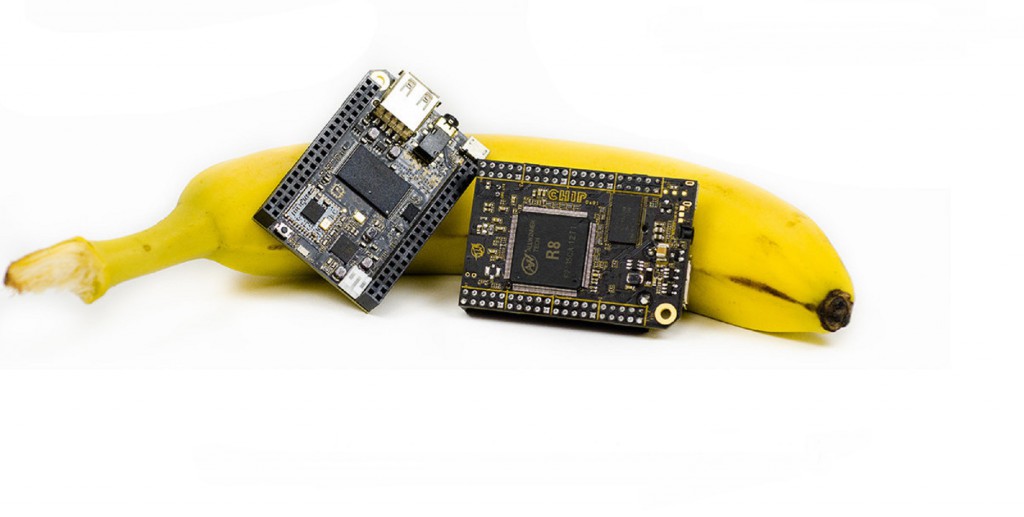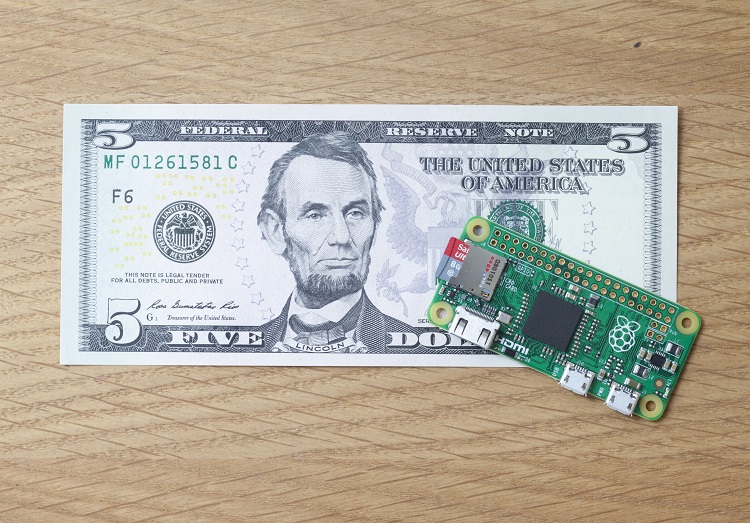
Chip, the nano-computer that costs only $9… but raised $2 million from its crowdfunding campaign. © DR
It’s raining circuit boards! With new PCBs coming out almost every month, rapid prototyping kits are proving the success of the Internet of Things with apprentice makers. Makery selected its top 10.
From bubbling start-ups to the plethora of (more or less successful) crowdfunding campaigns, the rapid prototyping market is beginning to look like a jungle. Makery introduces 10 new hardware platforms designed to make life easier for budding makers—focusing on playful tools to prototype the Internet of Things (IoT) while having fun. Not just for kids.
See our previous Top 10 hardware prototyping kits
7 boards to keep an eye on
Raspberry Pi Zero: most expected

What is it? A $5 nano-computer. The Pi Zero, latest addition to the (big) family of Raspberry computers has everything the big boards have—but cheaper! Even smaller than a credit card (6.5 cm by 3 cm), this miniature computer connects to a keyboard and a screen with all the basic functions of a PC.
What can it do? Besides its built-in applications, it can run programs such as Scratch, Minecraft and Sonic Pi games.
How does it work? Despite its mini size, it’s equipped with a Broadcom BCM2835 processor and ARM11 core cadenced at 1 GHz, which means that it’s 40% faster than the Raspberry Pi 1. Bonus: it includes a micro-USB port for data and power, mini-HDMI video output and micro-SD card reader.
Who makes it? The Raspberry Pi foundation, a charity organization in Wales that promotes programming in schools, launched the Pi Zero on the market in November 2015. Raspberry doesn’t cut corners—in February, the foundation had already launched its second generation of nano-computers, the Raspberry Pi 2.
How much does it cost? Sold for only $5 (4.50€), its mini price positions it as one of the cheapest nano-computers on the market.
Eben Upton, CEO of Raspberry Pi Trading, presents the Pi Zero:
More info on Raspberry Pi Foundation website
Limifrog: most Frenchie
What is it? An open source programmable module equipped with a 32-bit microcontroller for prototyping “intelligent” objects.
What can it do? Ideal for API, Limifrog is optimized for IoT applications (wearables, robots…)
How does it work? Programmable in C or C++, the board includes an ultra low power STM32L4 (ARM Cortex-M4) microcontroller and a bunch of sensors (atmospheric pressure and altitude, temperature and ambient light, accelerometer, gyroscope, magnetometer…). It connects to PC, smartphones and tablets via USB 2.0 or Bluetooth.
Who makes it? A French team, which launched a Kickstarter campaign for the project that raised $31,615 (29,060€) by the time it ended in September 2015. The first modules will be delivered from February 2016.
How much does it cost? Between $75 (69€) and (97€) according to configuration.
Demonstration of a robot prototyped with Limifrog:
More info on Limifrog
Beaglebone Enhanced: most agile
What is it? Beaglebone Enhanced is open hardware rapid prototyping.
What can it do? Like Raspberry Pi, this microcontroller combines the capacity of a nano-computer running Linux and the agility of Arduino.
How does it work? Upgraded from its predecessor, Beagleboneblack, Beaglebone Enhanced has 1 GB of RAM DDR3, 3 USB ports, a 6-axis MEMS gyroscope/accelerometer, as well as temperature and atmospheric pressure sensors.
Who makes it? The British company Sancloud, which presented it at the last CES in Las Vegas in early January 2016. It should get its own crowdfunding campaign soon.
How much does it cost? Not available.
Presentation of Beaglebone Enhanced:
More info on Beaglebone Enhanced
Mcookies: most funky
What is it? Mcookies are prototyping modules that are compatible with Lego bricks and Arduino boards.
What can it do? Like Littlebits, these modules make rapid prototyping more intuitive. With their colorful perforated plastic hooks, they can easily attach onto Lego projects.
How does it work? Each type of module is distinguished by color: red for USB and power, yellow for functions (motion, clock), blue for wifi or Bluetooth connections, green for extensions (motor, display, etc). Compatible with Arduino, the modules can be programmed in Scratch or Arduino IDE.
Who makes it? Microduino, which released them a bit late, after a successful Kickstarter campaign that ended in June 2015 ($167,500 or 154,500€). At CES 2016, the studio confirmed that Mcookies are now available.
How much does it cost? $99 to $299 (90€ to 275€) according to the kit.
Presentation of Mcookies:
More info on Microduino
See Mcookies tutorials and project ideas on Microduino wiki
Chip: most… cheap
What is it? Chip is an open hardware computer that costs only… $9.
What can it do? E-mail, two-player games, OpenOffice… Chip is delivered with a dozen pre-installed applications and tools.
How does it work? Simply connect a screen, keyboard and mouse. Equipped with a 1 Ghz processor, 512 MB RAM and 4 GB of storage, it communicates via wifi or Bluetooth.
Who makes it? Chip took home the jackpot on Kickstarter— California-based Nextthing raised a total of 2 million dollars, well beyond their goal of $50,000. Shipping scheduled for June 2016.
How much does it cost? 9$ (8€).
Presentation of Chip:
More info on Chip
Movi: most chatty
What is it? Movi (My Own Voice Interface) is a voice recognition interface and voice synthesizer that is compatible with Arduino.
What can it do? Movi can program voice commands to turn the light on or off, send commands to your smartphone or PC, sequence conversations to interact with objects, robots…
How does it work? Simply connect an Arduino board and a speaker, as it requires neither Internet connection nor external storage. English only for now.
Who makes it? Audeme, start-up founded by Gerald Friedland and Bertrand Irissou following their meeting in 2014 at the University of California in Berkeley, where they were researching acoustics applied to robotics. Shipping from February 2016.
How much does it cost? $89.99 (83€).
Presentation of Movi:
More info on Movi
Esplight: most luminous
What is it? Esplight is an open source board that allows you to control LEDs via wifi.
What can it do? Control the intensity and chromatic variations of the LEDs, with fade effect or in “rainbow” mode, for example.
How does it work? Compatible with all types of wifi networks, Esplight connects directly to your PC running Windows or Linux.
Who makes it? Michiel Brink, a Dutch student who describes himself as a “hacker, nerd and geek” fan of open source electronics. This modest member of Tkkrlab hackerspace in Enschede (Netherlands) launched a Kickstarter campaign to raise 1,000€ ($1,087). He came out with 1,500€ ($1632), enough to deliver the first controllers. At least he’s honest: delivery dates are pretty random.
How much does it cost? $22 (20€)
Presentation of Esplight:
More info on Esplight
3 playful IoT kits
Mesh: most childlike
What is it? Made in Japan, Mesh is a prototyping kit for anyone to playfully appropriate IoT.
What can it do? Completely wireless and paired with an intuitive visual interface, these colorful dominos can be attached to objects in order to animate them or transform them into controllers or sensors that trigger other playful or practical actions.
How does it work? Each module has a specific function and is connected via Bluetooth. Currently, 7 modules are available: button, LED, “move” orientation sensor, motion sensor, brightness sensor, temperature sensor and GPIO (General Purpose Input Output).
Who makes it? Launched in July 2015, Mesh emerged from an experimental project developed at Sony Japan.
How much does it cost? $50 to 60$ (46€ to 65€) per module.
Presentation of Mesh:
More info on Mesh
Iqube: most educational
What is it? Purely educational, Iqube is literally a cube game to initiate children to building electronic circuits.
What can it do? Designed for children aged 8 and above, these colorful magnetic 4 cm cubes can be assembled to create simple circuits in order to understand how a switch works, for example. At a more advanced stage, they can demonstrate through practical examples complex laws and theories of electricity, such as Ohm’s law.
How does it work? The tactile magnetic cubes can be connected together to form command strings. An application soon to be available in the Apple Store and Google Play will list about a hundred projects to create.
Who makes it? Three Filipino engineers and designers who are passionate about education and learning by doing. Following a successful crowdfunding campaign ($59,500 or 55,000€) which ended in early 2016, the first modules should be delivered in June.
How much does it cost? $119 (110€) for the basic kit, which includes 8 modules.
Presentation of Iqube:
More info about Iqube on Indiegogo
Meccanoid: most friendly
What is it? A programmable humanoid robot that walks and talks.
What can it do? Designed for kids aged 10 and above, Meccanoid G15 KS is an open source robot that you build yourself. The size of a human child (1.20 meters tall), it can walk, talk and imitate gestures.
How does it work? The polycarbonate robot is made up of 1,223 pieces, 2 motors and 8 servomotors for the arms and head. Programmable through an open source robotics platform and equipped with voice recognition, it can have a simple conversation, record video and communicate with other devices via Bluetooth.
Who makes it? The historical company Meccano, famous for its little cars and metal construction kits.
How much does it cost? $399.99 (359€) online.
Presentation of Meccanoid:
More info on Meccano